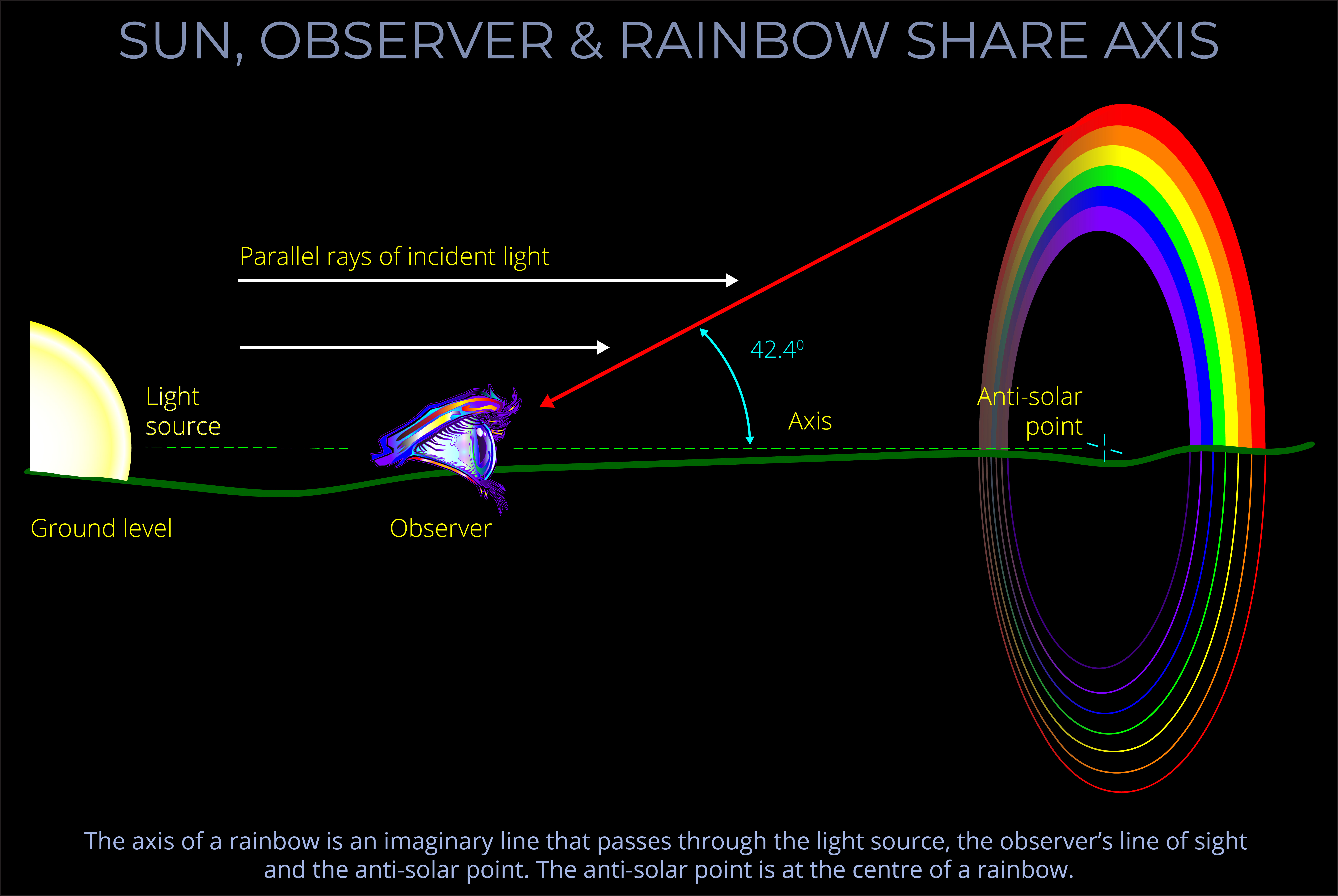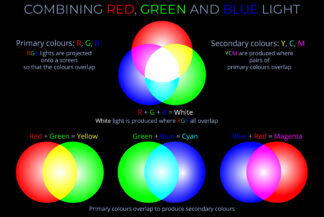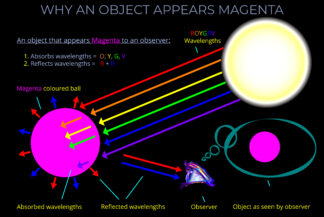Sun Observer & Rainbow Share Axis
£0.00
This is one of a set of almost 40 diagrams exploring Rainbows.
Each diagram appears on a separate page and is supported by a full explanation.
- Follow the links embedded in the text for definitions of all the key terms.
- For quick reference don’t miss the summaries of key terms further down each page.
Description
Sun, Observer & Bow Share Common Axis
TRY SOME QUICK QUESTIONS AND ANSWERS TO GET STARTED
About the Diagram
An overview of rainbows
About the diagram
Some Key Terms
On a sunny day, if you stand with the Sun at your back and look at the ground, the shadow of your head will align with the antisolar point.
- The antisolar point is the position directly opposite the Sun, around which the arcs of a rainbow appear. An imaginary straight line can always be drawn that passes through the Sun, the eyes of an observer, and the antisolar point, which is the geometric centre of a rainbow.
- This concept corresponds with what an observer sees in real life: the idea that a rainbow has a center. From a side view, the centre of a rainbow is called the antisolar point, so named because it is opposite the Sun relative to the observer’s position.
- Unless observed from the air, the antisolar point is always below the horizon. Both primary and secondary rainbows share the same antisolar point, as do higher-order bows, such as fifth and sixth-order rainbows.
When discussing rainbows, angular distance is the angle between the line from the observer to the centre of the rainbow (rainbow axis) and the line from the observer to a specific colour within the arc of a rainbow.
- See this diagram for an explanation: Angular distance & Raindrop colour
- Angular distance is one of the angles measured on a ray-tracing diagram that illustrates the sun, an observer, and a rainbow from a side view.
- Think of angular distance as the angle between the line to the centre of a rainbow down which an observer looks and the line to a specific colour in its arc. The red light is deviated by about 42.4° and violet light by about 40.7°.
In the field of optics, dispersion is shorthand for chromatic dispersion which refers to the way that light, under certain conditions, separates into its component wavelengths, enabling the colours corresponding with each wavelength to become visible to a human observer.
- Chromatic dispersion refers to the dispersion of light according to its wavelength or colour.
- Chromatic dispersion is the result of the relationship between wavelength and refractive index.
- When light travels from one medium (such as air) to another (such as glass or water) each wavelength is refracted differently, causing the separation of white light into its constituent colours.
- When light undergoes refraction each wavelength changes direction by a different amount. In the case of white light, the separate wavelengths fan out into distinct bands of colour with red on one side and violet on the other.
- Familiar examples of chromatic dispersion are when white light strikes a prism or raindrops and a rainbow of colours becomes visible to an observer.
An artificial light source is any source of light created by humans, as opposed to natural light sources like the sun or stars. Artificial light sources are generated by converting different forms of energy into light.
- There are several major categories of artificial light sources such as:
- Incandescent: These work by heating a filament until it glows, emitting light (traditional light bulbs).
- Fluorescent: Electric current triggers gas inside the bulb to produce ultraviolet light, which a phosphor coating converts into visible light.
- LED (Light-Emitting Diode): Electricity excites semiconductors, causing them to emit light.
- Gas-discharge lamps: Electric current passes through a gas, producing bright light (e.g., neon signs, street lamps).
Refraction refers to the way that electromagnetic radiation (light) changes speed and direction as it travels across the boundary between one transparent medium and another.
- Light bends towards the normal and slows down when it moves from a fast medium (like air) to a slower medium (like water).
- Light bends away from the normal and speeds up when it moves from a slow medium (like diamond) to a faster medium (like glass).
- These phenomena are governed by Snell’s law, which describes the relationship between the angles of incidence and refraction.
- The refractive index (index of refraction) of a medium indicates how much the speed and direction of light are altered when travelling in or out of a medium.
- It is calculated by dividing the speed of light in a vacuum by the speed of light in the material.
- Snell’s law relates the angles of incidence and refraction to the refractive indices of the two media involved.
- Snell’s law states that the ratio of the sine of the angle of incidence to the sine of the angle of refraction is equal to the ratio of the refractive indices.
A light source is a natural or man-made object that emits one or more wavelengths of light.
- The Sun is the most important light source in our lives and emits every wavelength of light in the visible spectrum.
- Celestial sources of light include other stars, comets and meteors.
- Other natural sources of light include lightning, volcanoes and forest fires.
- There are also bio-luminescent light sources including some species of fish and insects as well as types of bacteria and algae.
- Man-made light sources of the most simple type include natural tars and resins, wax candles, lamps that burn oil, fats or paraffin and gas lamps.
- Modern man-made light sources include tungsten light sources. These are a type of incandescent source which means they radiate light when electricity is used to heat a filament inside a glass bulb.
- Halogen bulbs are more efficient and long-lasting versions of incandescent tungsten lamps and produce a very uniform bright light throughout the bulb’s lifetime.
- Fluorescent lights are non-incandescent sources of light. They generally work by passing electricity through a glass tube of gas such as mercury, neon, argon or xenon instead of a filament. These lamps are very efficient at emitting visible light, produce less waste heat, and typically last much longer than incandescent lamps.
- An LED (Light Emitting Diode) is an electroluminescent light source. It produces light by passing an electrical charge across the junction of a semiconductor.
- Made-made lights can emit a single wavelength, bands of wavelengths or combinations of wavelengths.
- An LED light typically emits a single colour of light which is composed of a very narrow range of wavelengths.
Reflection is the process where light rebounds from a surface into the medium it came from, instead of being absorbed by an opaque material or transmitted through a transparent one.
- The three laws of reflection are as follows:
- When light hits a reflective surface, the incoming light, the reflected light, and an imaginary line perpendicular to the surface (called the “normal line”) are all in the same flat area.
- The angle between the incoming light and the normal line is the same as the angle between the reflected light and the normal line. In other words, light bounces off the surface at the same angle as it came in.
- The incoming and reflected light are mirror images of each other when looking along the normal line. If you were to fold the flat area along the normal line, the incoming light would line up with the reflected light.
Sunlight, also known as daylight or visible light, refers to the portion of electromagnetic radiation emitted by the Sun that is detectable by the human eye. It is one form of the broad range of electromagnetic radiation produced by the Sun. Our eyes are particularly sensitive to this specific range of wavelengths, enabling us to perceive the Sun and the world around us.
- Sunlight is only one form of electromagnetic radiation emitted by the Sun.
- Sunlight is only a very small part of the electromagnetic spectrum.
- Sunlight is the form of electromagnetic radiation that our eyes are sensitive to.
- Other types of electromagnetic radiation that we are sensitive to, but cannot see, are infrared radiation that we feel as heat and ultraviolet radiation that causes sunburn.



